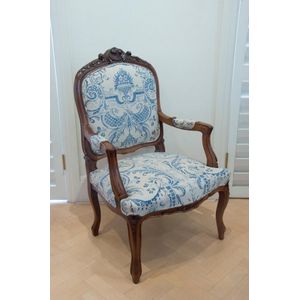Louis XV-style Beech Fauteuil a la Reine
An antique provincial Louis XV-style beech fauteuil a la reine, late19th century, the shaped and crested top-rail above the padded back and open arms, the seat above shaped rails on cabriole legs, carved decoration throughout. Height 106 cm. Width 69 cm. Depth 71 cm
You must be a subscriber, and be logged in to view price and dealer details.
Subscribe Now to view actual auction price for this item
When you subscribe, you have the option of setting the currency in which to display prices to $Au, $US, $NZ or Stg.
This item has been sold, and the description, image and price are for reference purposes only.
- Beech - Beech, a pale coloured timber, is native to temperate Europe, Asia and North America and classified as a hardwood, although comparitively "soft" when compared with oak or ash. It has long been popular with with country craftsmen, particulary chair makers, as unlike ash it is suitable for turning.
- Cabriole Leg - The cabriole leg evolved from an elongated scroll, curving out at the knee which may or may not be carved, and forming a serpentine shape as it descends to the foot.
First introduced into English furniture in the late 17th century, cabriole legs were widely used during the Queen Anne and early Georgian periods, where they frequently terminated in a pad foot or ball and claw foot. The style has had many imitators since then. The cabriole leg was re-introduced in the mid-19th century, and is commonly associated with the balloon-back dining or drawing-room chairs made in walnut, mahogany or, in Australia, cedar. The Victorian cabriole leg, on the whole, was rather more slender than the earlier form, following the French style, which emphasized the delicacy and daintiness of the chairs they were designed to support. Cabriole legs are sometimes found on windsor chairs, especially those made during the 18th century.
This item has been included into following indexes:
-
chairs, singles / pairs / threes, style or period
- fauteuils (arm chairs) 244
- French 966
Visually similar items

A French Louis XV style upholstered chair.
Sold by
in
for
You can display prices in $Au, $US, $NZ or Stg.

A French louis XV style armchair
Sold by
in
for
You can display prices in $Au, $US, $NZ or Stg.

A pair of Louis XV style walnut finish fauteuils
Sold by
in
for
You can display prices in $Au, $US, $NZ or Stg.

Edwardian ivory inlaid side chair with olive velvet upholstered seat
Sold by
in
for
You can display prices in $Au, $US, $NZ or Stg.
